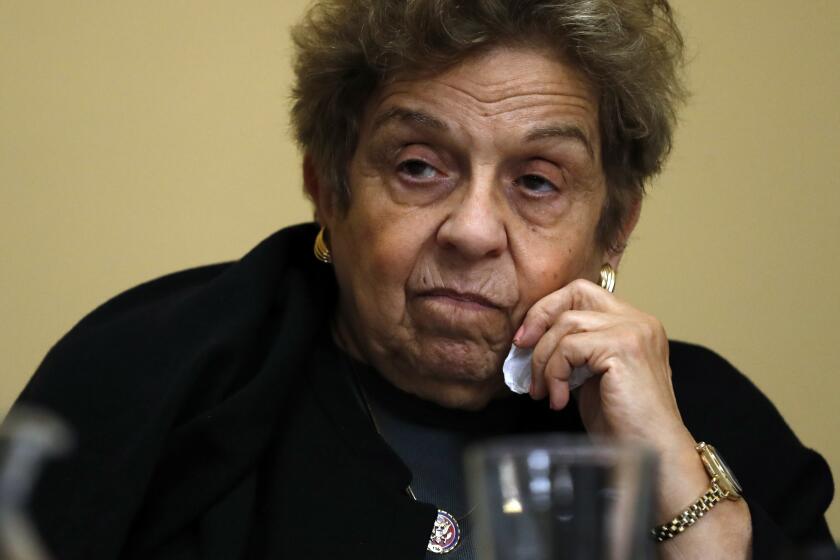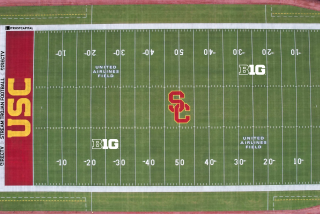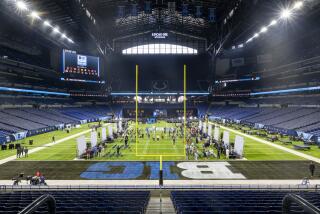Internal NCAA report reveals worries over athlete pay, lawsuits amid amateurism debate

- Share via
Last spring, an NCAA working group gathered at a Dallas-area hotel to discuss a strategic vision for the billion-dollar organization.
Each attendee received a 44-page report marked “Privileged and Confidential — Not for Distribution” filled with anonymous feedback from top college athletics officials. The document, obtained by The Times through a public records request, provides a rare look into the unfiltered thoughts of 52 university presidents and chancellors, athletic directors, conference commissioners, NCAA staffers and others on key issues facing the organization.
There are concerns about media coverage of the NCAA, plaudits for initiatives to improve the health and academic success of athletes, worry about the influence of money, frustration with the organization’s thick rule book and widespread apprehension regarding the future of amateurism, lawsuits and whether athletes should be able to make money off their name, image and likeness.
“The general public does not view the NCAA in a positive light. There was a huge communication plan to fix this, but then the scandals ruined that,” one person said in response to a question about an opportunity the organization should leverage.
“It is a hard environment with these sports writers who think amateurism is ludicrous. I think there is room for the definition of amateurism to evolve. In some sports, it is okay for students to compete in non-collegiate competition, like the Olympics, where there is an opportunity to make money through endorsements. And this inconsistency is ridiculous to me. Treat student-athletes like other students. If a pianist got an endorsement from Steinway, we go, yay. If it is an athlete, totally different story.”
Another respondent took a different position: “I know people fear the pendulum will swing too far to support student-athletes’ rights. How do we strike a balance so we are still mentoring, educating and developing young people?”
The debate in the document will continue in person during the annual NCAA convention that runs Wednesday through Saturday in Anaheim. It is the first gathering of the more than 1,110 schools that make up the organization since Gov. Gavin Newsom signed a bill in September that allows college athletes in California to receive endorsement deals starting in 2023.
Though NCAA officials called the bill an “existential threat” and “unconstitutional,” similar legislation is being prepared or has been introduced in at least two dozen states. The passage of the California bill — helped by high-profile endorsements from athletes such as LeBron James — transformed an issue that has simmered for years into a front-burner crisis for the organization that could fundamentally change how it operates.
The NCAA’s Board of Governors has green-lighted changing name, image and likeness rules “in a manner consistent with the collegiate model.” What that means isn’t yet clear, though the NCAA has rejected paying athletes for participating in sports. The convention will discuss “general concepts” about potential rule changes, but a vote on legislation to address the issue isn’t expected until next year.
The report, completed in the months before name, image and likeness became a topic of national discussion, shows the diverging views on whether the NCAA should change. NCAA President Mark Emmert and 13 focus groups were among those who provided input.
Should the NCAA double down on fundamental principles like amateurism? Or revamp the concept in response to changing times?
“Using the word ‘amateurism’ is a loser long term,” one respondent said. “We are the only ones left who use it. It’s a lack of credibility issue. We are using the word … because we have to with these lawsuits.”
Another comment respondent warned that the NCAA gets “bogged down and lost in issues of eligibility and amateurism” and if an athlete “has a brilliant idea whether it’s in physics or marketing herself, I don’t have a problem …”
Other respondents pushed back.
“The biggest threat is that the court system will force us to start paying athletes. And that will be the end of amateur sports as we know it,” one commented. “I think if we did a better job to show the academic benefits of playing college sports, it would take a lot of wind out of the balloon. All of the perks like letter jackets, cost of attendance, ring, etc.”
Another said: “We just need to do a better job at predicting the legal and congressional likelihoods. I really believe so many of our ills would be cured if there were legitimate minor league basketball and football teams.”
In response to a question about the biggest threat facing the NCAA, one person expressed wide-ranging worry about who is driving any changes.
“Our future is being determined outside of our intentions,” their comment said. “We are going to face a future that we are not creating. It will be created for us by those in courts or outside of our boardrooms.”
Another comment was concerned that the “bulk of the membership is not there” if the NCAA moved “from a system where we support amateur athletics to one … supporting semi-professional athletics.”
Respondents also viewed “competitive and economic pressures” as a threat — comments assailed coach buyouts and “lavish” spending on facilities — in addition to “public perception.” Many appeared to view NCAA difficulties as less about policies and more about perception.
U.S. Reps. Donna Shalala and Ross Spano introduce legislation that would create a Congressional Advisory Commission on Intercollegiate Athletics.
“The excessive negative publicity the NCAA gets from sports writers who have different agendas and different values,” one comment said. “They don’t buy into the whole success vision of the student-athlete. This has hurt the NCAA in the past number of years.”
“We have to be the ones creating the story,” another respondent said. “Because in today’s day and age of everyone wanting to get clicks, we will have a lot of people out there who will take shots and say things that aren’t accurate and/or factual.”
A similar survey of the Board of Governors is attached to the 44-page document. The group selected communications as the NCAA’s top weakness. That drew twice as many responses as the second-place answer of governance.
“Our main weakness is that we still do not do an adequate job of informing the public about the good work we do,” one respondent said.
The board’s discussion about threats mirrored the broader survey and hinted at the struggle that remains over how athletes are allowed to use their name, image and likeness.
“Legislation adverse to our values,” another respondent said, “is by far our greatest threat.”
More to Read
Go beyond the scoreboard
Get the latest on L.A.'s teams in the daily Sports Report newsletter.
You may occasionally receive promotional content from the Los Angeles Times.













